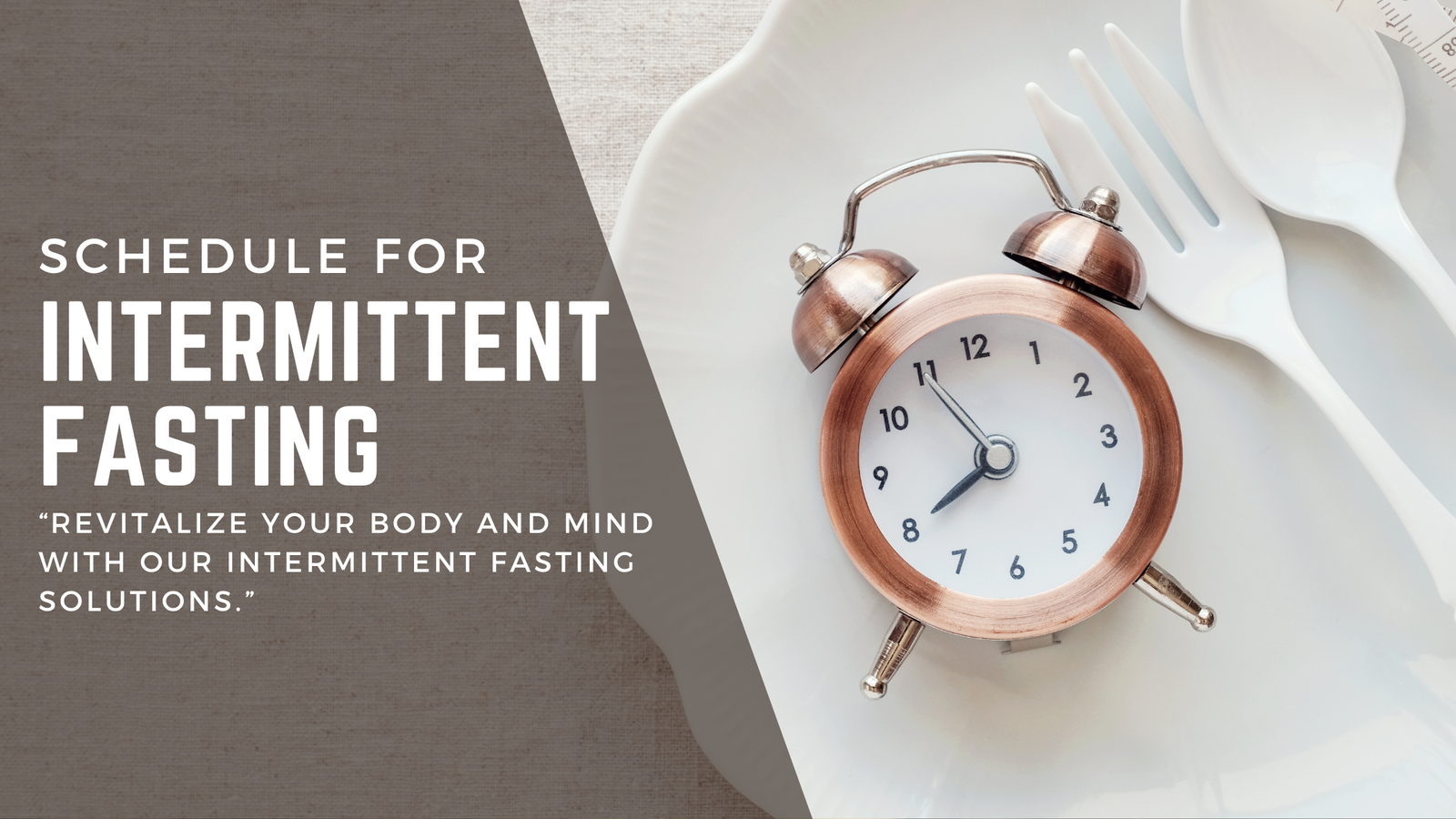Introduction to a Suitable Schedule for Intermittent Fasting for Beginners
Intermittent fasting, also known as periodic fasting or cyclical fasting, is a popular dietary approach that alternates between periods of eating and fasting. It’s not about what you eat, but rather when you eat. The schedule for intermittent fasting varies depending on the individual’s preferences and goals, but it typically involves a period of fasting that ranges from 12 to 48 hours, followed by a period of unrestricted eating.
Types of Intermittent Fasting
There are several methods of intermittent fasting, each with its own fasting schedule or fasting plan. Here are some of the most popular ones:
Time-Restricted Eating
Time-restricted eating, also known as scheduled feeding or timed eating, involves fasting every day for a certain number of hours and eating in the remaining hours. A popular example is the 16/8 method, which features a daily 16-hour fast and an 8-hour eating window.
The 5:2 Diet
The 5:2 diet, also known as the five-two diet or two-day fasting, involves eating normally for five days of the week and restricting your calorie intake on the remaining two days.
Alternate-Day Fasting
With alternate-day fasting or every-other-day fasting, the goal is to fast every other day. This is a more extreme form of intermittent fasting and may not be suitable for beginners.
The Warrior Diet
The Warrior Diet involves eating very little during a 20-hour fasting window and then eating one large meal at night. This form of fasting is also known as 20-hour fast or four-hour feeding.
Benefits of Intermittent Fasting
Intermittent fasting has been linked to a number of health benefits, including weight loss or fat reduction, improved metabolic health or metabolic function, and increased longevity. It’s also praised for its simplicity and sustainability, making it a popular choice for those looking to improve their health and lose weight.
The success of intermittent fasting greatly depends on the schedule you choose to follow. Whether you opt for daily time-restricted feeding or alternate-day fasting, finding a suitable schedule for intermittent fasting that aligns with your lifestyle and preferences is crucial to achieve desirable health outcomes including weight loss, improved metabolic function, and increased longevity.
Challenges and Considerations in Intermittent Fasting
While intermittent fasting can offer numerous benefits, it’s not without its challenges. Initial hunger and mood swings, adjusting to a new eating schedule, and potential health risks are all considerations to keep in mind. It’s also important to note that intermittent fasting isn’t suitable for everyone, and individuals with certain health conditions should consult with a healthcare professional before starting an intermittent fasting regimen.
Tips for Successful Intermittent Fasting
To maximize the benefits of intermittent fasting and make the process easier, here are some tips:
- Stay hydrated: Drink plenty of water and calorie-free drinks throughout the day.
- Avoid thinking about food: Plan distractions on fasting days to avoid thinking about food.
- Rest and relax: Avoid strenuous activities on fasting days.
- Make every calorie count: If your chosen plan allows some calories during fasting periods, select nutrient-dense foods that are rich in protein, fiber, and healthy fats.
- Eat high-volume foods: Choose filling yet low-calorie foods.
- Increase the taste without the calories: Season meals generously with garlic, herbs, spices, or vinegar.
Understanding the Science Behind Intermittent Fasting
Intermittent fasting works by shifting your body’s energy source from glucose to ketones, compounds that are produced when fat stores are broken down. This shift can lead to weight loss and improvements in various health markers.
The success of intermittent fasting greatly depends on the schedule you choose to follow. Whether you opt for daily time-restricted feeding or alternate-day fasting, finding a suitable schedule for intermittent fasting that aligns with your lifestyle and preferences is crucial to achieve desirable health outcomes including weight loss, improved metabolic function, and increased longevity.
Common Myths and Misconceptions about Intermittent Fasting
There are many misconceptions about intermittent fasting, such as the idea that it leads to muscle loss or that it’s the same as starvation. It’s important to understand the science behind intermittent fasting to debunk these myths.
Case Studies and Success Stories
There are numerous success stories and case studies that highlight the effectiveness of intermittent fasting. From significant weight loss to improvements in metabolic health, these stories serve as inspiration and proof of the power of intermittent fasting.
Q: What is an intermittent fasting schedule?
A: An intermittent fasting schedule is an eating pattern that alternates between periods of eating and fasting. It involves fasting for a certain number of hours each day or every other day depending on the chosen schedule.
Q: What kind of diet is intermittent fasting?
A: Intermittent fasting is not a specific diet and doesn’t require you to eat specific foods. It’s an eating pattern that specifies when to eat and when to fast, which can work with any type of diet.
Q: Is day fasting the same as alternate-day fasting?
A: No, day fasting and alternate-day fasting are different from each other. Day fasting involves fasting for 24 hours once or twice a week while alternate-day fasting involves alternating between a fasting day and a normal eating day.
Q: What are the ways to do intermittent fasting?
A: There are several ways to do intermittent fasting. Some popular methods include: 16/8 method (fast for 16 hours and eat within an 8-hour window each day), 5:2 method (eat normally for 5 days and restrict calories to 500-600 for 2 non-consecutive days), Eat-Stop-Eat (fast for 24 hours once or twice a week), and the Warrior Diet (eat one large meal at night and fast during the day).
Q: What is the best intermittent fasting schedule?
A: There is no universal best intermittent fasting schedule as the most effective one depends on the individual’s preferences, lifestyle, and health goals. However, the 16/8 method is considered the easiest and most sustainable one as it involves skipping breakfast and eating within an 8-hour window daily.
Q: What is a fasting plan?
A: A fasting plan is a specific intermittent fasting schedule that’s tailored to an individual’s needs and lifestyle. It can include the number of fasting hours, the frequency of fasting, and the type of food to eat during the eating windows.
Q: What are the different intermittent fasting schedules?
A: There are several different intermittent fasting schedules to choose from, including the 16/8 method, 5:2 method, Eat-Stop-Eat, Warrior Diet, and alternate-day fasting. Each method has its own benefits and drawbacks, so it’s important to find one that works best for you.
Q: Can intermittent fasting help with weight loss?
A: Yes, intermittent fasting can help with weight loss as it creates a calorie deficit by restricting the amount of time you have to eat. However, the weight loss results may vary depending on various factors like diet, age, gender, and initial weight.
Q: What is the fasting routine?
A: The fasting routine is a specific schedule that specifies when to fast and when to eat for an intermittent fasting regimen. It can involve fasting for 16 hours and eating within an 8-hour window every day or fasting for 24 hours once or twice a week, depending on the chosen method.
Q: Is it safe to practice intermittent fasting?
A: Intermittent fasting can be safe and beneficial for some people who have no history of eating disorders and don’t experience any negative side effects while fasting. However, it may not be suitable for everyone, especially pregnant or breastfeeding women, people with medical conditions, and those with a history of eating disorders.
Conclusion
In conclusion, intermittent fasting is a versatile and effective dietary approach that can lead to weight loss and improved health. Whether you choose the 16/8 method, the 5:2 diet, alternate-day fasting, or the Warrior Diet, the key is to find a method that fits your lifestyle and preferences. Always remember to listen to your body and consult with a healthcare professional if you have any concerns. Happy fasting!




Leave a Reply